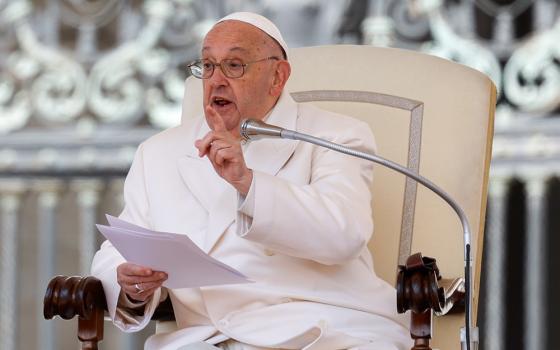THE SOCIAL MISSION OF THE U.S. CATHOLIC CHURCH: A THEOLOGICAL PERSPECTIVE
By Charles E. Curran
Published by Georgetown University Press, $26.96
Charles Curran is a careful writer because what he writes is controversial. In The Social Mission of the U.S. Catholic Church, the controversial part comes in the last chapter, on the U.S. bishops and abortion law. Curran offers themes and arguments we have encountered before: a revisionist moral theology, a progressivist social ethic, and an Americanist historiography, all couched in a typically moderate prose style.
For 50 years this moral theologian has produced books and articles at an impressive rate. When updated this year, his bibliography (including edited volumes) will exceed 300 items.
The plot line, the church’s social mission from colonial Maryland up to the 2008 national election, highlights Catholics’ movement out of their own subculture into the U.S. mainstream. Along the way, Curran discusses a host of people and movements: social justice advocate Msgr. John Ryan, interracial justice activist Jesuit Fr. John LaFarge, the Catholic Association for International Peace, the Legion of Decency, and the Christian Family Movement, to name a few.
Catholic efforts for social change in first half of the 20th century were impeded, Curran contends, by a two-tiered notion of nature and grace and a clerical model of leadership that obscured the full religious character of working for “temporal” or social change.
| NCR - April 15, 2011 Also in this issue: - US News: Abuse & Justice Irish archbishop speaks at Marquette - Special Section: Ecology Bringing creation care to seminaries; McKibben; and more - Opinion: Ethical Shopping Balancing faith and buying habits |
| Subscribe now |
This changed with Vatican II, which injected vitality and purpose into the church’s social mission, thanks to its integrated conception of nature and the supernatural, its robust theology of baptism, and its vision of social change as spiritual or religious in nature. Catholic health care and charities moved from a model of “care for one’s own” to a more inclusive mission.
Curran writes glowingly of the 1976 Call to Action conference, especially its collaboration between clergy and laity. He commends the bishops involved in the early 1970s United Farm Workers struggle for striking the proper balance of prophetic challenge, education and formation, and advocating concrete labor reforms. Likewise, the U.S. bishops’ pastoral letter “The Challenge of Peace” struck a balance between a prophetic or “witness” approach to peacemaking and a concern for effectiveness. Curran argues this same balance is needed when it comes to abortion. He sketches in the limits of the pro-life movement’s militant wing and applauds a more moderate approach, as exemplified by Fordham University sociologist James Kelly -- an approach present-day bishops lack.
Curran reviews the U.S. Catholic bishops on abortion law from 1968 to 2009, and criticizes their recent stance: “The bishops have claimed too much certitude in their position on abortion law and have failed to recognize that Catholics may legitimately hold other positions.” He gives three reasons why:
- There is “speculative doubt” among moral theologians about the soul being infused into the embryo at fertilization, in which case it is not a person and thus aborting it is not murder.
- The bishops adopt a “common good approach” to the role of law, but it is also valid to espouse a “religious freedom approach,” which is more tolerant of moral diversity.
- The bishops say that abortion must be outlawed because it is an intrinsic evil, but other intrinsic evils -- contraception, masturbation and lying -- are not outlawed because it would be unfeasible, because there is a lack of moral consensus, or both. For Curran the same holds true for abortion.
These three critiques are worth a closer examination for Curran is right -- the intrinsically evil nature of an act does not, in itself, mean it should be illegal. Otherwise, the police would have to start kicking in doors and rounding up all the masturbators. It is the gravity of certain evil acts that makes it necessary to criminalize them -- with abortion, the gravity of taking an innocent life. But taking life in capital punishment or war are grave matters as well. How to deal with all this in U.S. politics is a complex matter of prudential judgment. But when Catholic bishops use the “intrinsic evil” line to insist, or strongly imply, that criminalizing abortion trumps all other political concerns and that Catholics must vote accordingly -- that is, Republican -- Curran is right to object.
On the other hand, Curran’s claim that the fetus is not a person until infused with a soul is not very compelling.
 Some moral theologians, citing the fact that theologians in the past supposed that ensoulment occurs at the 40-day mark or later, argue a window of opportunity exists during which a pregnancy can be terminated without being an “abortion.” Curran claims that such “speculative doubt” can allow an early-stage abortion, a strategy from the manual tradition known as “probabilism.”
Some moral theologians, citing the fact that theologians in the past supposed that ensoulment occurs at the 40-day mark or later, argue a window of opportunity exists during which a pregnancy can be terminated without being an “abortion.” Curran claims that such “speculative doubt” can allow an early-stage abortion, a strategy from the manual tradition known as “probabilism.”
But this will not ring true until expectant couples start throwing ensoulment parties or declaring, in the sad aftermath of a miscarriage, “We lost the fetus.” In these matters, ordinary language and practice reflect the truth more clearly than the rarified speculations of moral theologians.
Curran distinguishes between a “common good” approach to law and politics, which he attributes to the bishops, and a “religious freedom” approach, attributed to Jesuit Fr. John Courtney Murray. Conservative followers of Murray will not agree, but it is valid in that Murray argued that some practices contrary to the common good (pornography, contraception) should be legally tolerated for the sake of freedom within the bounds of public order. Curran wants to put abortion on that list -- but not racist or genocidal policies. Question: Why not?
Pro-lifers are sure to draw parallels, to which Curran would probably object, and then the discussion would lapse into the all-too-familiar debate between liberal and conservative Catholics. Curran says that a flexible approach to abortion law holds more promise among Catholics, especially younger Catholics. Conservatives disagree. And so the debate goes.
Overlooked here is that a growing number of Catholics, including young ones, identify themselves as neither liberal nor conservative. They think that abortion ends a baby’s life, that waterboarding is torture, and that “Catholic social teaching” is being distorted by political operatives of both parties in order to capture Catholic (swing) votes. This breed of Catholic looks elsewhere than to the nation-state for genuine political community, to local communities where the common good is embodied with more meaningful deliberation, with truer freedom. Curran writes of the Catholic Worker, which is one such example, but he is wary of its countercultural tendencies.
For Curran, as for many of his generation, the story of Catholics entering the U.S. mainstream is a success story. There is little sense of a downside, little probing, for example, of the challenges facing Catholic hospitals and social agencies in retaining their institutional identity and mission. To pursue these concerns may seem to him like a step into the past, into the subculture we thankfully left behind. But it may also be a step into the future, into a form of the church that we cannot fully imagine.
Who could have predicted in 1961 (the year Curran started publishing), all that has since transpired in Catholicism in the United States? Likewise, none of us can rule out the possibility that in 50 years we Catholics may finally realize that our social mission, to paraphrase Peter Maurin, is to build a new society in the shell of the old.
[Michael Baxter teaches theology at the University of Notre Dame in Indiana and is director of the Catholic Peace Fellowship.]



